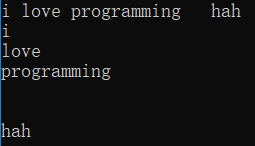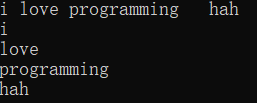版权声明:转载时打个招呼。 https://blog.csdn.net/qq_15971883/article/details/86515037
本题出自K&R《C程序设计语言》,练习1-12:编写一个程序,以每行一个单词的形式打印其输入。
这里对单词的定义比较宽松,它是任何其中不包含空格、制表符或换行符的字符序列。
一开始的想法是:
#include <stdio.h>
int main(void)
{
int c;
while ((c = getchar()) != EOF)
{
if (c == ' ' || c == '\t' || c == '\n')
{
putchar('\n');
}
else
{
putchar(c);
}
}
system("pause");
return 0;
}但是,连续出现空格或制表符时,将会出现如下情况:
结果中会出现有的行中没有单词,这不符合题目要求的“每行一个单词”,因此需要修改程序。有必要记录“连续出现空格或制表符”的情况,因此需要一个变量来记录状态。修改之后的程序如下:
#include <stdio.h>
#define INSPACE 1 // in space
#define NOT_INSPACE 0 // not in space
int main(void)
{
int c;
int state = NOT_INSPACE;
while ((c = getchar()) != EOF) // while c is not EOF
{
if (c == ' ' || c == '\t' || c == '\n')
{
if (state == NOT_INSPACE)
{
state = INSPACE;
putchar('\n');
}
else
{
; // else, don't print anything
}
}
else
{
state = NOT_INSPACE;
putchar(c);
}
}
system("pause");
return 0;
}运行结果如下:

